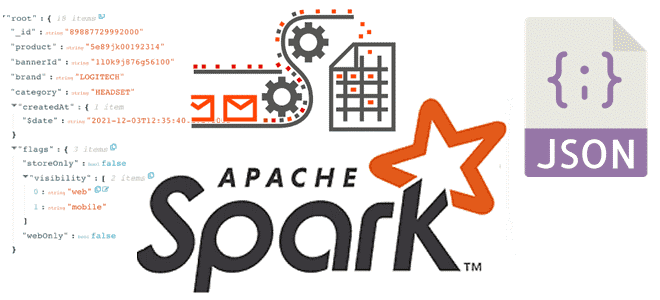公司记录日志的时候,将请求数据和返回数据以JSON格式存储到了数据库中,为了更高的处理这部分JSON数据,就用到了SparkSQL自带的一些JSON函数。这里做这些函数的方法做了一些整理。

get_json_object(json_txt, path)
get_json_object是SparkSQL提供的一个内置函数,用于从JSON字符串中提取嵌套的字段。该函数接受两个参数:一个JSON字符串和一个JSON路径。
- 第一个参数json_txt是一个包含JSON对象的字符串列。
- 第二个参数path是一个JSON路径,用于指定你想从JSON对象中提取哪个字段。这个路径应该以$开头,每个子字段用.分割。例如,如果JSON对象是{“a”:{“b”:1}},你可以用$.a.b来提取值1。
以下是一个SQL查询的例子,它使用get_json_object函数提取JSON字符串中的字段:
SELECT get_json_object(json_column, '$.field1') FROM table;
这个查询会返回json_column中field1字段的值。如果field1是一个嵌套的字段,你可以使用$.field1.subfield1这样的路径来提取它。
如果JSON路径不存在,或者JSON字符串无法解析,get_json_object函数会返回NULL。
如果你的JSON字符串包含一个数组(列表),你仍然可以使用get_json_object函数。你只需要在JSON路径中加上数组索引。请注意,索引是从0开始的。
例如,假设json_column包含一个如下的JSON对象:
{"array":[1,2,3]}
你可以使用以下的查询来获取数组的第一个元素:
SELECT get_json_object(json_column, '$.array[0]') FROM table;
这个查询会返回1。
如果你想获取数组的所有元素,你可以使用explode函数配合get_json_object使用。首先,你需要把JSON字符串转换为一个SparkSQL的array类型,然后使用explode函数创建一个新的行,每个行代表数组的一个元素。
如果你有一个包含多个JSON对象的数组,并且想从每个对象中提取id字段,你可以使用类似于以下的查询:
SELECT get_json_object(json_column, '$.array[*].id') FROM table;
这种方法应该可以工作,但是它会返回一个包含所有id值的数组,而不是一个包含多行的表格。
json_array_length(jsonArray)
json_array_length的作用是返回JSON数组中元素的数量。
代码示例:
SELECT json_array_length('[1,2,3,4]');
或者可以结合get_json_object使用,例如:
SELECT json_array_length(get_json_object(json_text, '$.products[*].items')) FROM table
json_object_keys(json_object)
以数组形式返回最外层JSON对象的所有键。示例:
json_object_keys({"f1":"abc","f2":{"f3":"a","f4":"b"}})
返回的是[f1,f2]
或者可以结合get_json_object使用,例如:
SELECT json_array_length(get_json_object(json_text, '$.products[0]')) FROM table
json_tuple(jsonStr, p1, p2, …, pn)
json_tuple是SparkSQL中的一个函数,它用于从JSON字符串中提取特定的字段。它会返回一个包含n个字段值的元组。
你可以像下面这样使用json_tuple函数:
SELECT json_tuple(json_column, 'field1', 'field2', ..., 'fieldn') FROM table;
在这个SQL语句中,json_column是你的JSON字符串所在的列,’field1′,’field2′,…,’fieldn’是你想从JSON字符串中提取的字段的名称。
例如,如果你有一个包含多个JSON对象的列,并且想从每个对象中提取id和name字段,你可以这样做:
SELECT json_tuple(json_column, 'id', 'name') FROM table;
这将返回一个包含id和name字段值的元组。
schema_of_json(json[, options])
schema_of_json是SparkSQL中的一个函数,它用于从JSON字符串中推断出其schema。
示例:
SELECT schema_of_json('[{"col":0}]');
+---------------------------+
|schema_of_json([{"col":0}])|
+---------------------------+
|ARRAY<STRUCT<col:...|
+---------------------------+
SELECT schema_of_json('[{"col":01}]', map('allowNumericLeadingZeros', 'true'));
+----------------------------+
|schema_of_json([{"col":01}])|
+----------------------------+
|ARRAY<STRUCT<col:...|
+----------------------------+
但是个人城市后发现一直报错,原因好像是JSON字符串中有NULL值。due to data type mismatch: The input json should be a foldable string expression and not null;
from_json(jsonStr, schema[, options])
from_json是SparkSQL中的一个函数,它用于将JSON字符串解析为一个SparkSQL可以理解的结构化数据格式。
- 函数的第一个参数jsonStr是包含JSON数据的字符串。
- 第二个参数schema是一个描述所需数据结构的字符串,它定义了JSON数据的预期格式。
示例:
SELECT from_json('{"teacher":"Alice","student":[{"name":"Bob","rank":1},{"name":"Charlie","rank":2}]}','STRUCT<teacher:STRING,student:ARRAY<STRUCT<name:STRING,rank:INT>>>');
这里的 schema 可以使用 SparkSQL 中的 DDL(Data Definition Language)语法,该语法是一种更简洁的方式来定义数据结构。
以下是一些常用的数据类型和它们的 DDL 表示:
- string:字符串类型。
- int:整数类型。
- double:双精度浮点数类型。
- boolean:布尔类型。
- date:日期类型。
- timestamp:时间戳类型。
你还可以使用 DDL 语法来定义更复杂的数据类型,如数组、映射和结构等。例如:
- array<type>:这定义了一个数组,数组中的元素都是同一类型。例如,array<int> 是一个整数数组。
- map<type,type>:这定义了一个映射,其中的键和值可以是任何类型。例如,map<string,int> 是一个键为字符串、值为整数的映射。
- struct<field1:type1,field2:type2,…>:这定义了一个结构,结构中可以包含多个字段,每个字段都有一个名称和类型。例如,struct<name:string,age:int> 是一个包含名为 “name” 的字符串字段和名为 “age” 的整数字段的结构。
关于你之前提到的 from_json 函数中的 schema,你可以使用 DDL 语法来定义 JSON 数据的预期结构。例如:
from_json(json_column,'struct<name:string,age:int,pets:array<string>,isAlive:boolean>')
在这个例子中,DDL schema 定义了一个名为 “name” 的字符串字段、一个名为 “age” 的整数字段、一个名为 “pets” 的字符串数组字段和一个名为 “isAlive” 的布尔字段。
to_json(expr[,options])
to_json 是 SparkSQL 的一个函数,它用于将一个结构化数据转换成 JSON 格式的字符串。
expr 是要转换成 JSON 的表达式,它通常是一个包含多个字段的结构或者一个 map。例如,你可以将一张表中的一行数据转换成 JSON:
SELECT to_json(struct(*)) as json FROM table;
在这个 SQL 语句中,struct(*) 创建了一个包含表中所有字段的新结构,然后 to_json 函数将这个结构转换成了 JSON 格式的字符串。
选项参数 options 是一个 JSON 格式的字符串,包含了转换过程中可用的选项。一个常用的选项是 dateFormat,它用于指定日期字段在 JSON 中的表示方式。例如:
SELECT to_json(struct(*),'{"dateFormat":"dd/MM/yyyy"}') as json
FROM table;
在这个 SQL 语句中,我们设定了日期格式选项,这会影响到日期字段在 JSON 中的表示方式。
explode(from_json(…))
将 from_json 的内容展成多行(应用于 ARRAY,每个元素 1 行)
示例:
SELECT q.text
FROM (
SELECT explode(from_json('[{"text":"Tea"},{"text":"Apple"}]','ARRAY<STRUCT<text:STRING>>')) AS q
);
更复杂的代码示例:
SELECT inquiry_id, product_name, item_name, item_charge_type, item_upper , item_lower, item_max_discount, res.name AS res_name, res.code AS res_code, res.carType AS res_car_type , res.chargeType AS res_charge_type, res.distance AS res_distance, res.duration AS res_duration, res.seats AS res_seats, res.merchantPrice AS res_mer_price , res.price AS res_price, res.finalPrice AS res_final_price, res.discount AS res_discount, res.heiJDiscount AS res_hj_discount, res.discounts AS res_discounts , res.priceAdjust AS res_price_adjust FROM ( SELECT inquiry_id, product_name, item.name AS item_name, item.chargeTypeName AS item_charge_type, item.upper AS item_upper , item.lower AS item_lower, item.maxDiscount AS item_max_discount, item.resources AS item_resources FROM ( SELECT inquiry_id, product.name AS product_name, product.items AS items FROM ( SELECT inquiry_id, from_json(inquiry_result,'struct<products:array<struct<name:string,items:array<struct<name:string,chargeTypeName:string,upper:string,lower:string,maxDiscount:string,resources:array<struct<name:string,code:string,carType:int,chargeType:int,distance:int,duration:int,seats:int,merchantPrice:string,price:string,finalPrice:string,discount:string,heiJDiscount:string,discounts:array<struct<name:string,type:string,batchNo:string,flashSale:boolean,amount:string>>,priceAdjust:struct<search:struct<amount:string,percent:string>,booked:struct<amount:string,percent:string>>>>>>>>>') AS products FROM table ) p LATERAL VIEW explode(p.products.products) exploded_table AS product ) i LATERAL VIEW explode(i.items) exploded_table AS item ) r LATERAL VIEW explode(r.item_resources) exploded_table AS res
参考链接:



